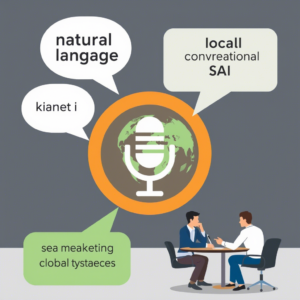Have you ever imagined having a real conversation with your customers, understanding not only what they say but also how they feel about your products or services? This is the promise of sentiment analysis. By turning words into emotions, businesses can create more personalized and satisfying experiences for their customers.
What is Sentiment Analysis and Why Does It Matter?
Have you ever tried to guess whether an email is good or bad just by reading the subject? Sentiment analysis does something similar, but on a larger scale and with much more precision. It’s like giving computers the ability to “feel” what people are saying.
But how do machines understand our emotions? Through Natural Language Processing (NLP) techniques, computers are trained to identify words and phrases that express positive, negative, or neutral feelings. For example, words like “excellent,” “loved,” and “wonderful” usually indicate a positive sentiment, while words like “bad,” “disappointed,” and “problem” indicate a negative sentiment.
But why is understanding people’s feelings so important? The answer is simple: emotions guide our decisions. When we are happy with a product or service, we are more likely to recommend it to others. On the other hand, when we are dissatisfied, we may stop being customers and spread negative opinions about the brand.
By understanding the feelings of their customers, businesses can:
- Identify problems: Discover the weak points of their products or services.
- Improve customer experience: Personalize interactions and offer more suitable solutions.
- Increase customer satisfaction: Make customers feel valued and heard.
- Boost sales: Identify cross-selling and upselling opportunities.
How Sentiment Analysis Can Be Used in Businesses
Sentiment analysis is not limited to understanding what customers think; it provides practical tools for businesses to improve their products, services, and customer relationships. Let’s explore some concrete applications:
Customer Service
Identify dissatisfied customers: Through the analysis of emails, chats, and social media comments, businesses can quickly identify customers who are experiencing issues and offer personalized support.
Generate automated responses: Chatbots and virtual assistants can use sentiment analysis to understand the tone of a conversation and provide more appropriate responses.
Prioritize cases: More urgent or impactful cases can be identified and resolved more quickly.
Marketing
Social media analysis: Monitor brand mentions and identify consumer perceptions about products and services.
Campaign optimization: Track the performance of advertising campaigns and adjust the strategy based on the results.
Audience segmentation: Create more personalized campaigns targeted at different customer segments based on their sentiments.
Product Development
Identify user needs and expectations: Analyze feedback and suggestions to improve existing products and services.
Test new products: Evaluate consumer reactions to new products or features before releasing them to the market.
Improve user experience: Identify friction points in the customer journey and implement improvements.
Reputation Management
Brand monitoring online: Track brand mentions across different channels and identify potential reputation crises.
Crisis management: Respond quickly to negative reviews and comments, minimizing the impact on the brand’s image.
Competitor analysis: Compare consumer perceptions of your brand and its competitors.
The Challenges of Sentiment Analysis
Although sentiment analysis is a powerful tool, it is not perfect. There are several challenges that need to be overcome for this technology to reach its full potential.
Sarcasm and irony: Human language is rich in nuances and irony, which can confuse algorithms. A sentence like “That’s great!” could express a positive or negative sentiment depending on the context.
Informal language and slang: Social media and online communication are marked by informal language and filled with slang and abbreviations, making it difficult to interpret feelings accurately.
Multiple languages and dialects: Sentiment analysis in different languages and dialects requires the creation of specific models, which can be challenging for companies operating in global markets.
Complex and ambiguous emotions: Sentiments are not always clear and defined. Often, people express mixed or complex emotions that are difficult to categorize.
Language evolution: Language is constantly evolving, with new words and expressions emerging all the time. Sentiment analysis models need to be continuously updated to keep up with these changes.
Despite these challenges, the scientific community and tech companies are investing in research to improve sentiment analysis techniques. New approaches, such as the use of neural networks and deep learning, are being developed to handle the complexity of natural language and improve result accuracy.
Tools and Technologies for Sentiment Analysis
To perform sentiment analysis, businesses rely on a variety of tools and technologies that utilize natural language processing (NLP) and machine learning techniques. Some of the most popular tools include:
NLTK (Natural Language Toolkit): An open-source Python library that provides a wide range of resources for natural language processing, including tools for tokenization, stemming, lemmatization, and sentiment analysis.
TextBlob: A Python library for natural language processing that simplifies tasks such as sentiment analysis, part-of-speech tagging, and translation.
VADER (Valence Aware Dictionary and sEntiment Reasoner): A lexicon and rule-based algorithm specifically designed to analyze sentiment in English texts.
Machine learning libraries: Libraries such as TensorFlow and PyTorch allow the creation of custom deep learning models for sentiment analysis, which can lead to more accurate results for complex tasks.
Data analysis platforms: Platforms like RapidMiner, KNIME, and Orange offer visual interfaces and workflows to build sentiment analysis models without needing to code.
How These Tools Work:
Preprocessing: The text is preprocessed to remove stop words, punctuation, and perform other cleaning tasks.
Feature extraction: Features such as words, n-grams, and emoticons are extracted from the text to train the model.
Model training: The sentiment analysis model is trained on a labeled dataset, where each example is associated with a sentiment (positive, negative, or neutral).
Classification: The trained model is used to classify new texts, assigning them a sentiment.
Choosing the right tool depends on various factors such as:
- Data size and complexity: For large volumes of data, more robust and scalable tools are needed.
- Natural language: The tool must support the language in which the data is written.
- Customization level: Some tools allow for high levels of customization, while others offer ready-to-use solutions.
- Budget: Commercial tools are usually more expensive than open-source options.
Sentiment Analysis Success Stories
Sentiment analysis is already being used by various businesses in different sectors, yielding significant results and transforming the way they interact with their customers. Here are some examples:
E-commerce: Major online retailers use sentiment analysis to monitor product reviews, identify key points of customer dissatisfaction, and improve product descriptions. This helps optimize the shopping experience and boost sales.
Customer service: Telecommunications companies and banks use sentiment analysis to identify dissatisfied customers, prioritize requests, and improve service quality. Sentiment-aware chatbots can offer more personalized and efficient responses to customers.
Social media: Marketing agencies and brands use sentiment analysis to monitor brand reputation on social media, identify influencers, and create more effective campaigns.
Market research: Market research companies use sentiment analysis to analyze satisfaction surveys, online forums, and other data sources to identify trends and market insights.
A practical example: A major fast-food chain used sentiment analysis to identify that customers were dissatisfied with wait times at drive-thru lanes.
Based on this information, the company implemented measures to speed up service and communicated estimated wait times to customers. The result was a significant improvement in customer satisfaction and an increase in sales.
Sentiment analysis can also be used to:
- Predict buying intent: Identify which customers are most likely to make a purchase.
- Detect reputation crises: Monitor social media to quickly identify any issues that may affect the brand’s image.
- Personalize customer experience: Offer more relevant product and service recommendations for each customer.
The Future of Sentiment Analysis: New Frontiers and Trends
Sentiment analysis is a constantly evolving field, driven by advancements in artificial intelligence and natural language processing. In the future, we can expect this technology to become even more sophisticated and integrated into various aspects of our lives.
Some of the main trends for the future of sentiment analysis include:
Multimodal sentiment analysis: Sentiment analysis will no longer be limited to text. More advanced models will be able to analyze sentiments from different types of data, such as images, videos, and audio. For example, it will be possible to analyze a customer’s sentiment while watching an advertisement or using a product.
Real-time sentiment analysis: Sentiment analysis will be able to process data in real-time, allowing companies to quickly respond to reputation crises and personalize the customer experience on the fly.
Contextual sentiment analysis: Models will be able to understand the context in which a phrase was said, enabling a more accurate interpretation of feelings. For example, the phrase “This is amazing” could have different meanings in different contexts.
Explainability of models: It will become increasingly important to understand how sentiment analysis models reach their conclusions. This will allow businesses to verify the reliability of results and identify potential biases in the data.
Integration with other technologies: Sentiment analysis will be integrated with other technologies, such as virtual reality and the Internet of Things, to create more immersive and personalized experiences.
Ethical and Legal Implications of Sentiment Analysis
With the rise of sentiment analysis and the growing collection of personal data, legitimate concerns about privacy arise. Collecting and analyzing data about people’s emotions and opinions can raise important ethical and legal questions.
Key Concerns:
Misuse of data: Data collected for sentiment analysis could be used for unauthorized purposes, such as creating detailed psychological profiles of individuals, manipulating opinions, and discrimination.
Privacy violations: Collecting data on people’s emotions could be considered an invasion of privacy, especially if done without explicit consent.
Bias in algorithms: Sentiment analysis algorithms may perpetuate existing societal biases, discriminating against minority groups or reinforcing stereotypes.
Data security: The collection and storage of large volumes of personal data increases the risk of leaks, which could have severe consequences for individuals.
Legal Concerns:
- Regulation: The lack of specific regulation around sentiment analysis creates an uncertain legal environment and makes it difficult to protect individuals’ rights.
- Consent: It is essential to obtain explicit consent from individuals before collecting and analyzing their data.
- Transparency: Companies must be transparent about the data they collect, how it’s used, and the measures they take to protect users’ privacy.
Measures to Mitigate Risks:
Privacy by design: Businesses should integrate privacy from the outset of product and service development, using technologies that minimize data collection and ensure anonymization when possible.
Transparency: Companies should be clear about their data collection and usage practices, providing users with clear information about their rights.
Informed consent: User consent should be obtained in a clear and unequivocal manner, informing them of the purposes of data collection and the consequences of their decision.
Data security: Companies should implement robust security measures to protect user data from unauthorized access and breaches.
Independent audits: Independent audits of sentiment analysis systems can help ensure businesses comply with privacy and security standards.
The Role of Governments in Sentiment Analysis Regulation
The growing use of sentiment analysis raises significant questions about the need for government regulation. The collection and use of personal data to determine individuals’ feelings and opinions can have a profound impact on society, necessitating the creation of clear and effective regulatory frameworks.
Why Regulation is Needed:
- Privacy protection: Collecting and using personal data for sentiment analysis must be done transparently and with explicit consent. Regulation can establish clear limits on data collection and use, ensuring privacy protection.
- Prevention of abuse: Regulation can help prevent the misuse of sentiment analysis, such as manipulating opinions, discrimination, and creating psychological profiles without consent.
- Transparency assurance: Companies using sentiment analysis should be transparent about their data practices, allowing individuals to understand how their information is used.
- Accountability: Regulation can establish mechanisms to hold companies accountable in case of privacy and security violations.
Challenges for Regulation:
Complexity of technology: Sentiment analysis is an evolving technology, making it challenging to create regulations that are both flexible and effective.
Balance between innovation and protection: Regulation needs to balance the protection of individuals’ rights with the promotion of technological innovation.
International cooperation: Sentiment analysis is a global activity, requiring international cooperation to establish common standards and avoid loopholes.
In conclusion, sentiment analysis is a powerful tool for understanding customer emotions and improving business strategies.
However, its growing use raises important ethical, legal, and technical challenges that must be addressed responsibly. Only by finding the right balance between innovation, privacy, and security can we ensure that sentiment analysis benefits businesses, customers, and society as a whole.




